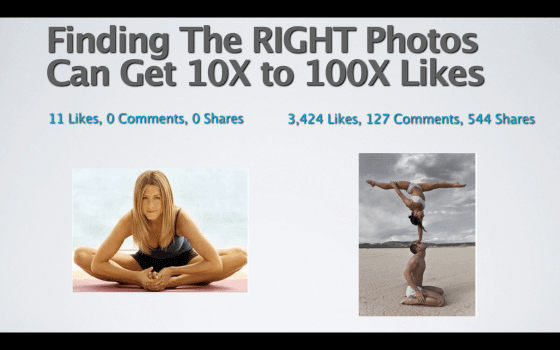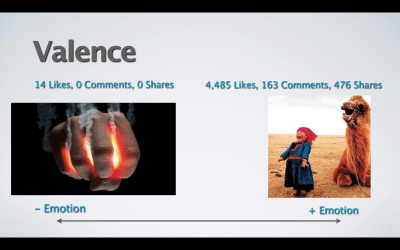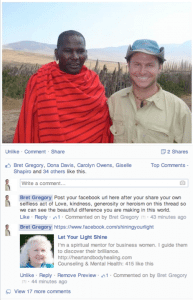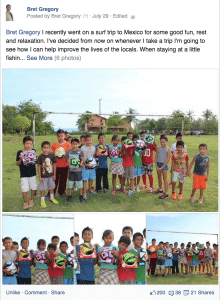- Course Progress 46%
Chapter 6 – Science Of Sharing
Part of being social beings is that we share. On Facebook we share content, stories, ideas, services, referrals and YOU. Social networks make it easy for us to share these parts of ourselves, and Facebook is no exception.
Best of all, scientific research has shown that what people like to share is actually pretty predictable.
The photos that go most viral have a high and positive emotional (valence) charge. Here is the “Viral Post Formula”;
Photo with High + Positive Emotional Charge
= Most Viral Content
Also, the “Super Viral Post Formula” is as follows;
Photos with stories of selfless acts of love,
kindness, generosity, or heroism.
What Do People Share Most on Facebook?
Facebook is set up to promote the sharing of photos, and they include this in their algorithms. People are 10 to 100 times more likely to share a photo than they are to share a post with no photo or a link. If you want to get your page to grow virally, you need to post “shareable” photos. In other words, you need to post photos that motivate people to click Share.
Finding the right photos can get you 10 to 100 times the number of Likes, Comments, and Shares. A fan posted the following two photos on our yoga page with 1.2 million Likes.

The photo on the left shows Jennifer Aniston, Hollywood actress, doing yoga. When it was posted on our page, it got only 11 Likes, no Comments, and no Shares. (Poor Jennifer!) Clearly, this was not the kind of content our fans wanted. Conversely, the photo on the right doesn’t even show someone doing yoga —it’s a couple doing acrobatics at Burning Man—yet, it got 3,424 Likes, 127 Comments, and 544 Shares.
The Science of Sharing
Dr. Kathleen Milkman, a professor of marketing at the Wharton School of Business, studied over 7,000 New York Times posts to see what made some go viral. She discovered something very interesting. She found that the posts that went most viral all had a very positive valence. That is, they had a positive emotional context. For example, when another fan posted these two photos on our wall, the photo on the left has a very negative emotion and only got 14 Likes. The photo on the right clearly conveys a very positive emotion where the kid and his camel are cracking up! It went viral with over 4,485 Likes.

Dr. Milkman also discovered that the most viral posts all had a very high emotional charge. Here is an example from our Yoga
page on Facebook. The photo on the bottom has a very low emotional charge; it’s a photo of a beautiful model doing yoga in a gorgeous outdoor setting, which only got 124 Likes. The photo on the top has a much higher emotional charge and is of a fantasy acrobat archer. This photo got 3,128 Likes.

Dr. Milkman coined the term “integral affect” to describe the correlation between photos with a high and positive emotional charge and how viral they become. The most viral photos come from this upper right-hand quadrant.

The Viral Post Formula
The photos that go most viral have a high and positive emotional (valence) charge.
Photo with High + Positive Emotional Charge
= Most Viral Content
Super-Viral Post Formula
After doing my own research of posting and studying over 10,000 Facebook posts, I’ve always been impressed by the photos and content that get over 100,000 Likes. I call these “Super-Viral Posts.” And, I’ve discovered the formula for them, too. Whenever you see a post that has over 100,000 Likes, it will probably follow this formula:
Photos with stories of selfless acts of love,
kindness, generosity, or heroism.
Here is a great example of a post that went super-viral on Facebook. It’s the story of John and his aging German Shepherd named Schoep. The pair went on their short daily walk; then, at the end, John took Schoep into Lake Superior, as the water alleviated the dog’s severe arthritis, and Schoep fell asleep peacefully in John’s arms.

Not only did this story get over 350,000 Likes, but it also touched the hearts of millions and was covered on many major news networks.
Here is another example of a true story of selfless love, kindness, and heroism.

The above story went super-viral and got over 500,000 Likes on Facebook.
If you want to see a great example of a page that posts tons of stories of selfless acts of love, kindness, generosity, and heroism, check out www.fb.com/Upworthy and you’ll see why they got over 6.2 million Likes.
Action step: On your next post, share your own selfless act of love, kindness, or generosity. It could be that you simply smiled at a stranger who was having a bad day, volunteered your time with a non-profit organization, cared for your loved ones, read to your children, or even bought school supplies for a local school.


For example, when I visited Africa, I was so moved by the Maasai tribe’s simple one-room, dirt-floor school for their children that I contributed some of my own funds to help them buy school supplies.

I believe that there is no act of kindness too small, and that you likely do more than you realize to spread love in this world, and that is worth sharing! You may find that the added side benefit of doing these kinds of posts on your Facebook page is that they are the most viral and will attract real, conscious customers who believe what you believe and will pay you well for your services.
Why Do People Share?
This begs the question, why do people share in the first place? People share content (mostly photos with stories) that represents the way they want to be perceived.
People share photos with stories that
represent the way they want to be perceived.
You’ll want to post content that makes your fans feel good about themselves and look good to others. Post content that is smart, funny, aware, or popular—content that makes people see things in a new light. That’s what gets shared and what will build your tribe of conscious customers now.
This is different from simply posting blog updates on your Facebook page, selling features or benefits like direct marketing does, or pushing brand imagery onto viewers who are passively consuming. No one likes a page that just tries to sell you their stuff or that is constantly posting the latest offer. That’s not how to build your tribe.
Conscious Customers
A conscious customer is a globally, socially conscious customer who prefers products and services from companies who give back to society and business dedicated to helping others. Nielsen, the large consumer rating consulting firm says that nearly half of conscious customers are willing to pay more for the products and services of a socially responsible entrepreneur or business. If your Facebook Page posts show your values by posting your own stories of your selfless acts of love, kindness and generosity, you are more likely to attract customers who value what you value and are willing to pay you well for your products and services.
What Are Your Customers’ Passions?
To find sharable content, ask yourself these questions: What do your customers care about? What makes them feel good and look good? Answer, then go create some positive and highly emotionally-charged content and post that on your page right now.
Universal Yet Personal
Though you are writing a message for all of your page followers in a universal way, write to them personally as if you are writing to one person, a friend you trust and know well. Don’t start your post with “Hey Everyone,” “Hi Gang,” or “Namaste Tribe.” Let your mental and emotional connection become apparent and evident. Here is an example of a post on my business facebook page that is universal yet personal;

I think it’s critical to be totally honest, transparent, and authentic, and the more you can do that, the more you will attract your tribe and the perfect customers whom you can best lead and serve.
Question: Do I need permission to share photos on Facebook? Facebook’s Terms of Service do not allow you to post someone else’s intellectual property. So in short, yes, you need permission to post someone else’s photo on your page.
Question: Where can I get great “shareable” photos that I don’t need permission to post?
My favorite place to get amazing sharable photos is Flickr. Go to www.flickr.com and do search for photos that your customers will want to share, like “inspirational quotes” or “world travel.” Filter for images with Creative Commons licenses that allow commercial use. Because all of these photos are already licensed for your use, you may use them — all you have to do is to give credit to the photographer and share the link where you found the image when you post them.

